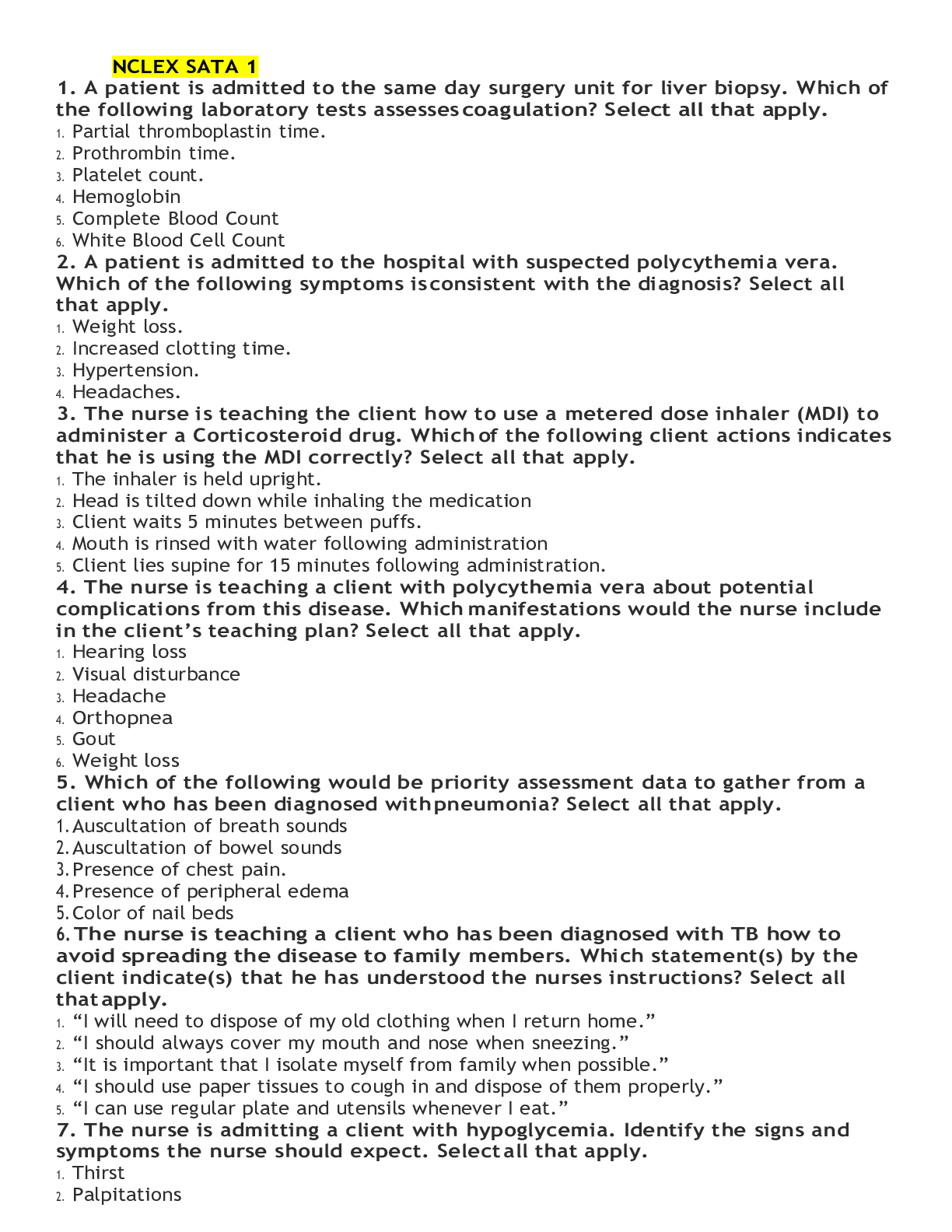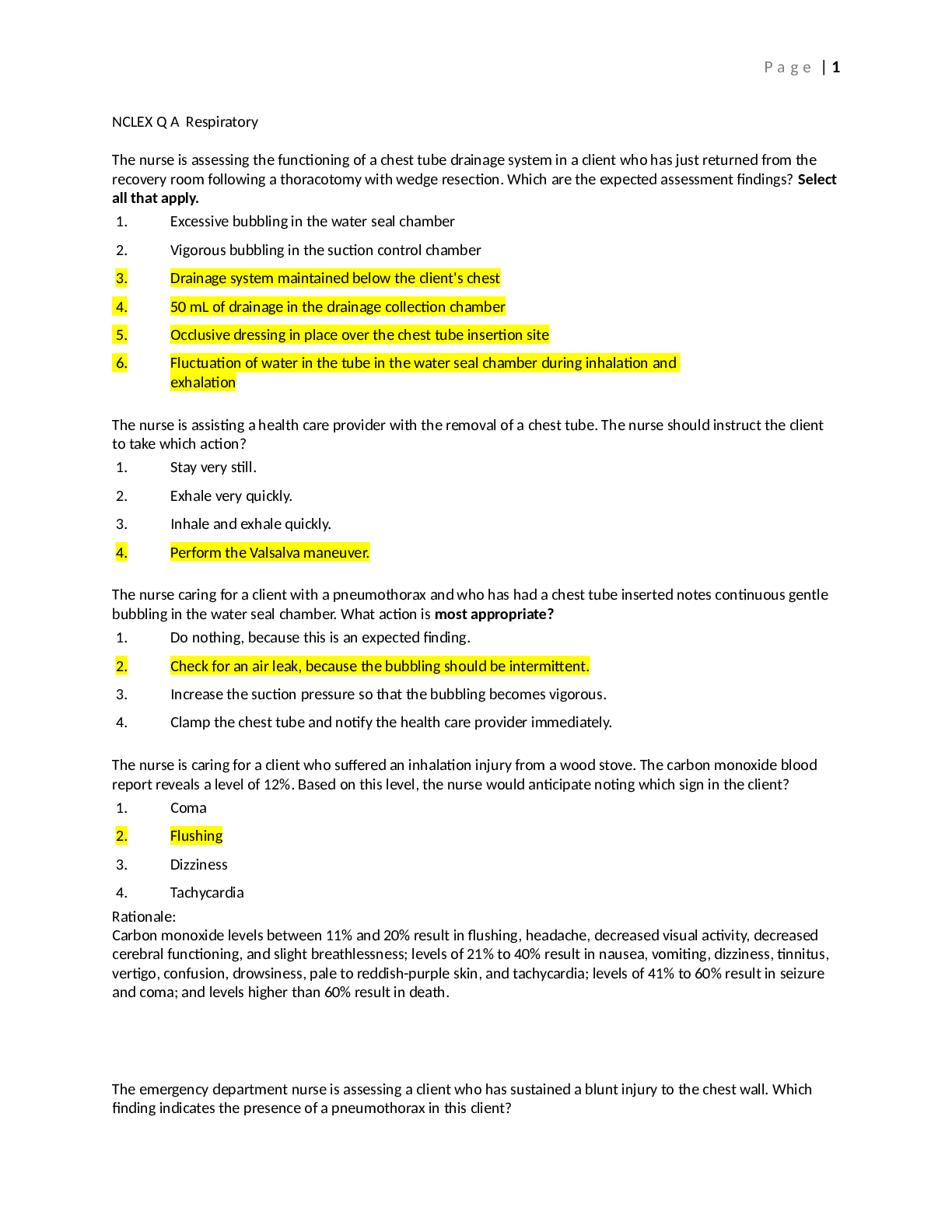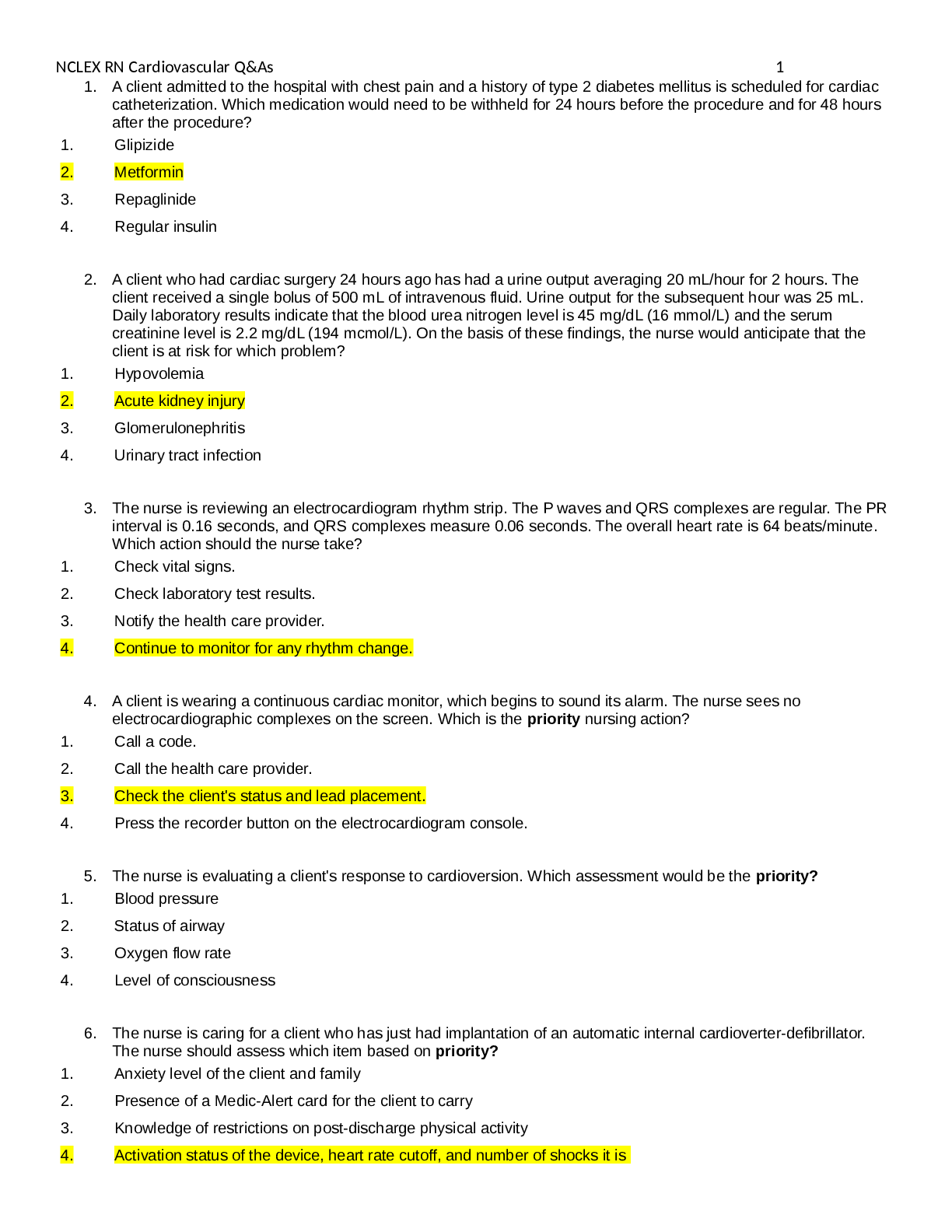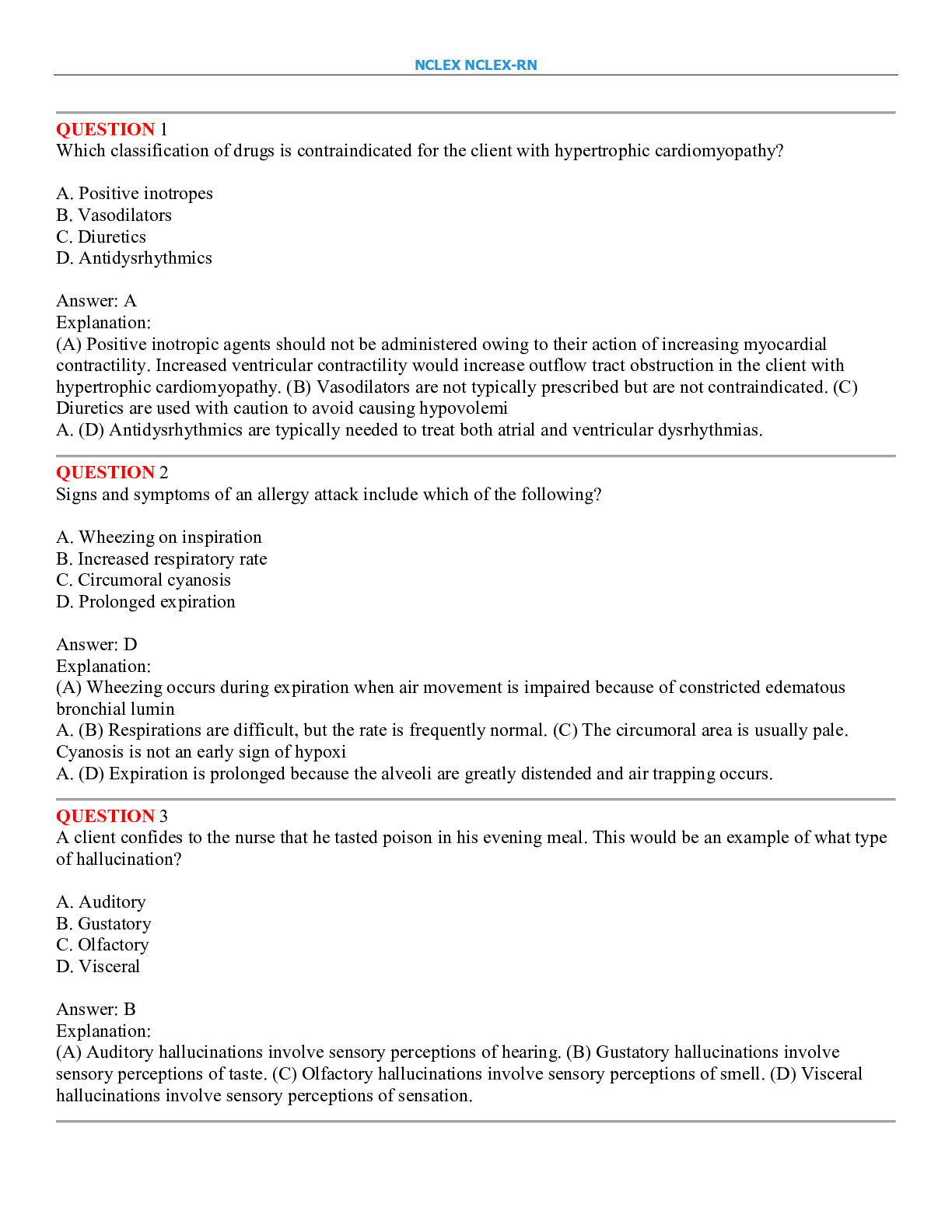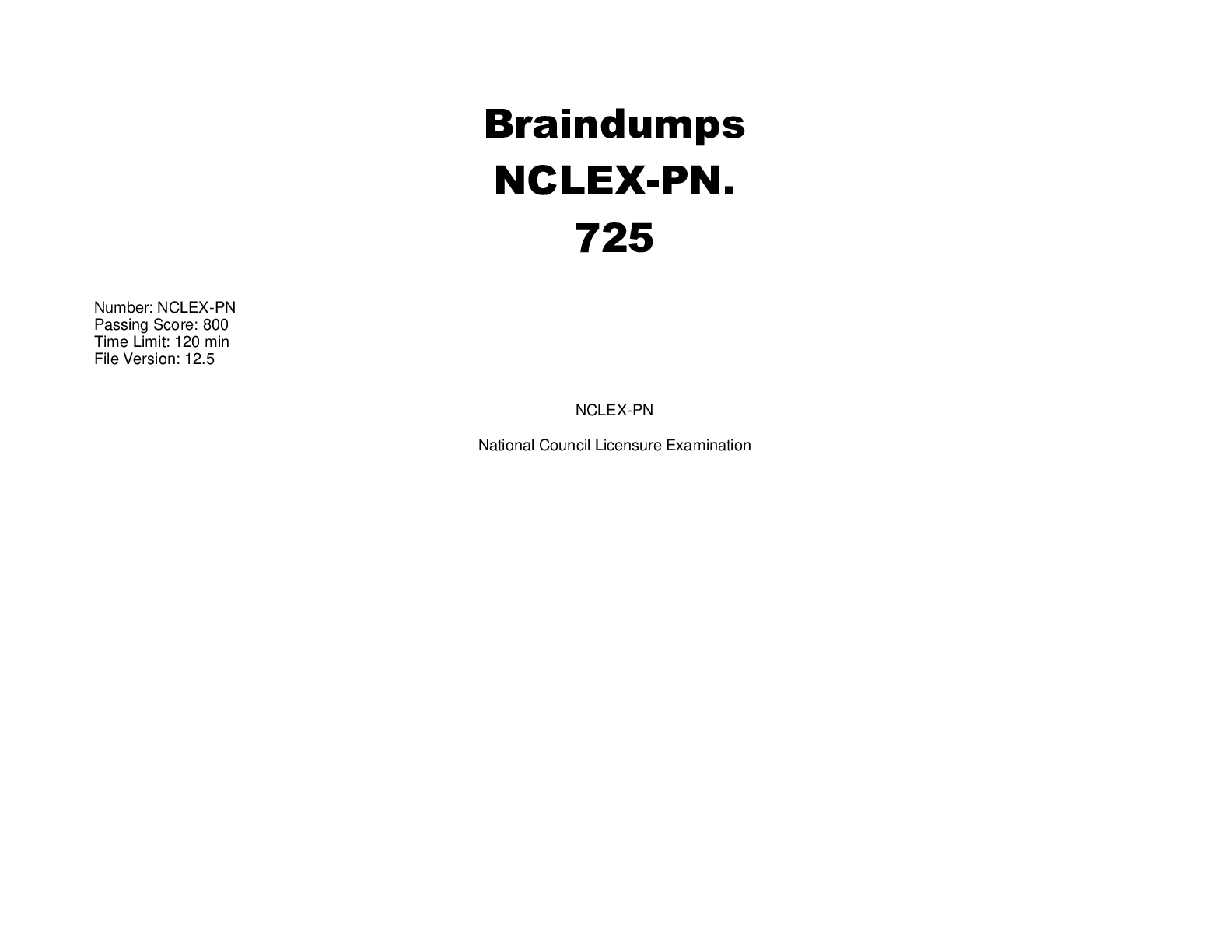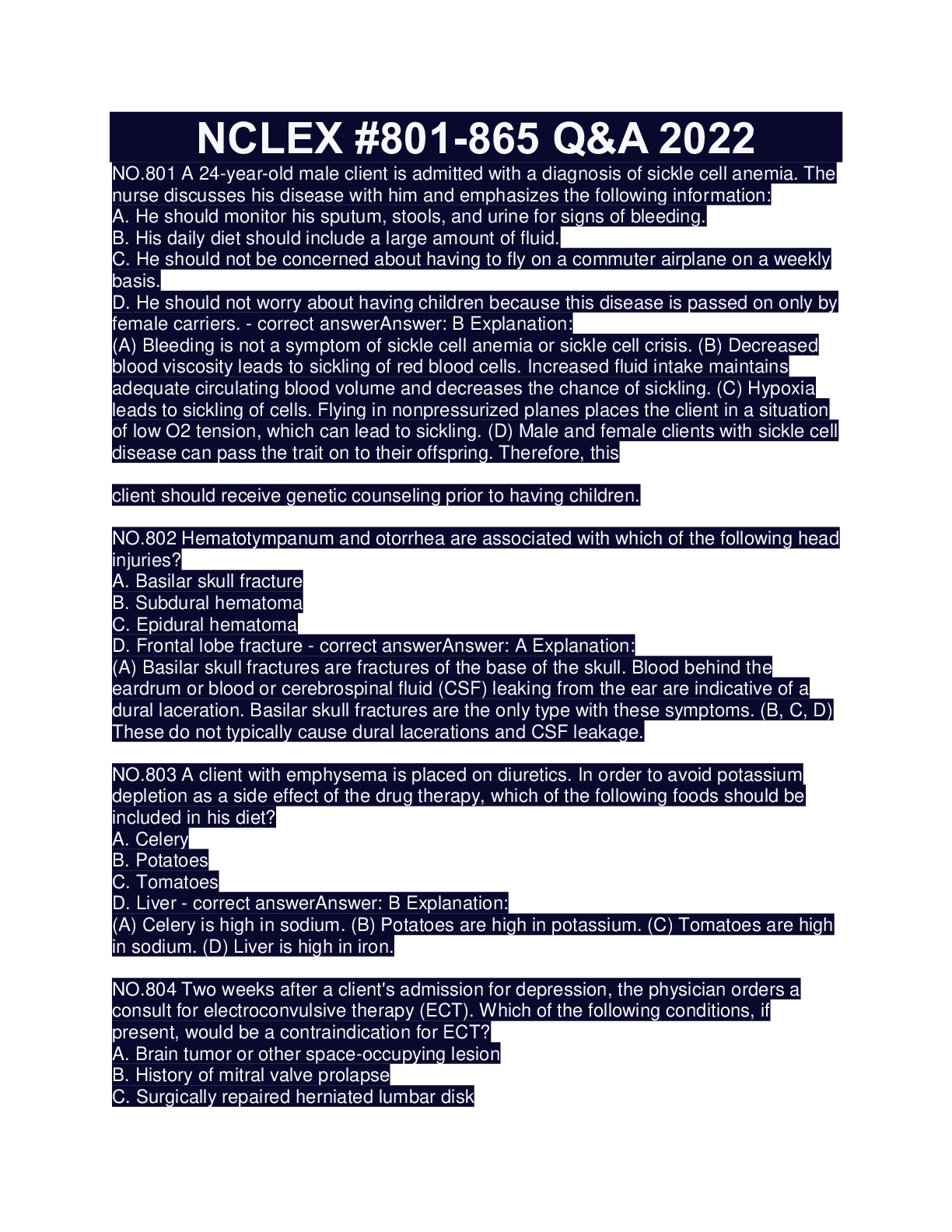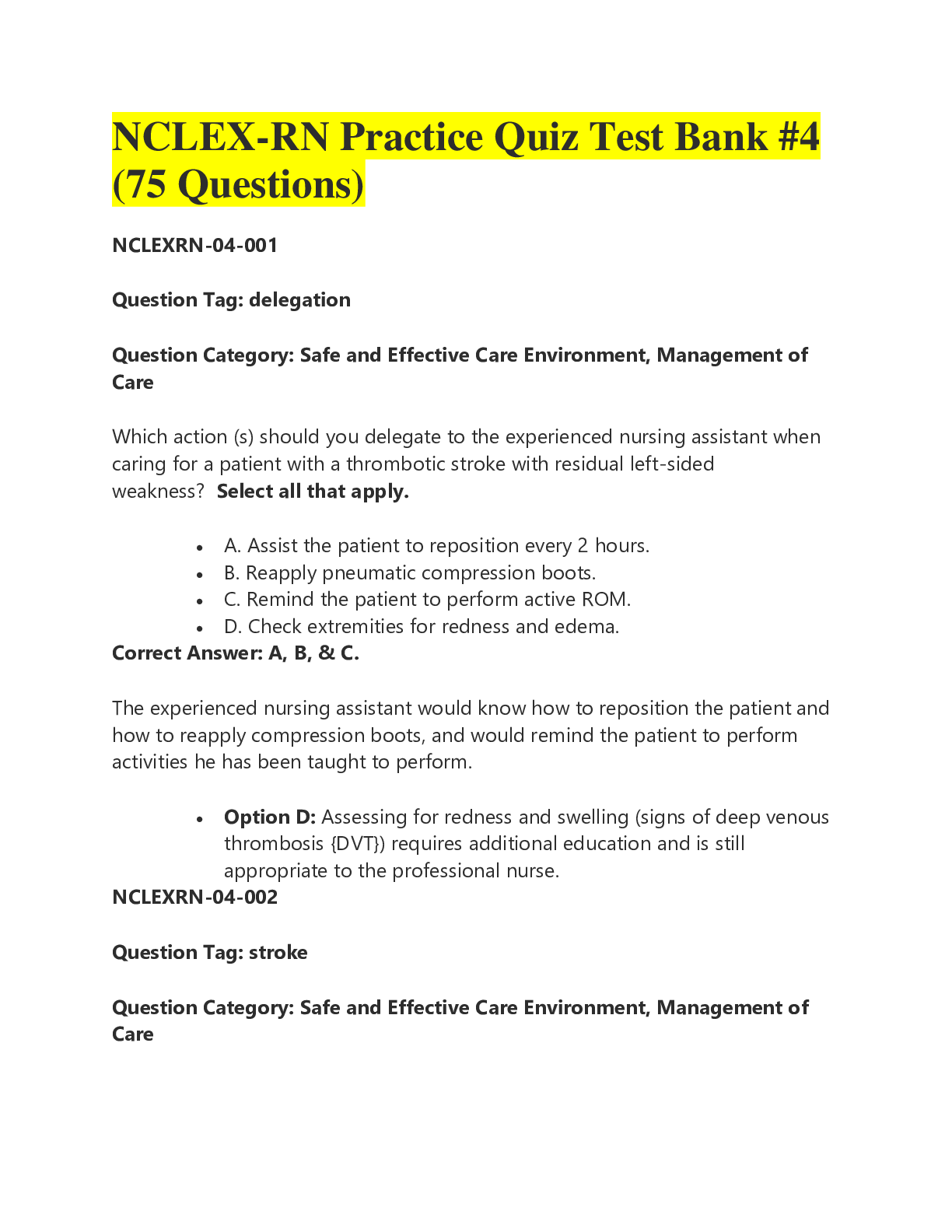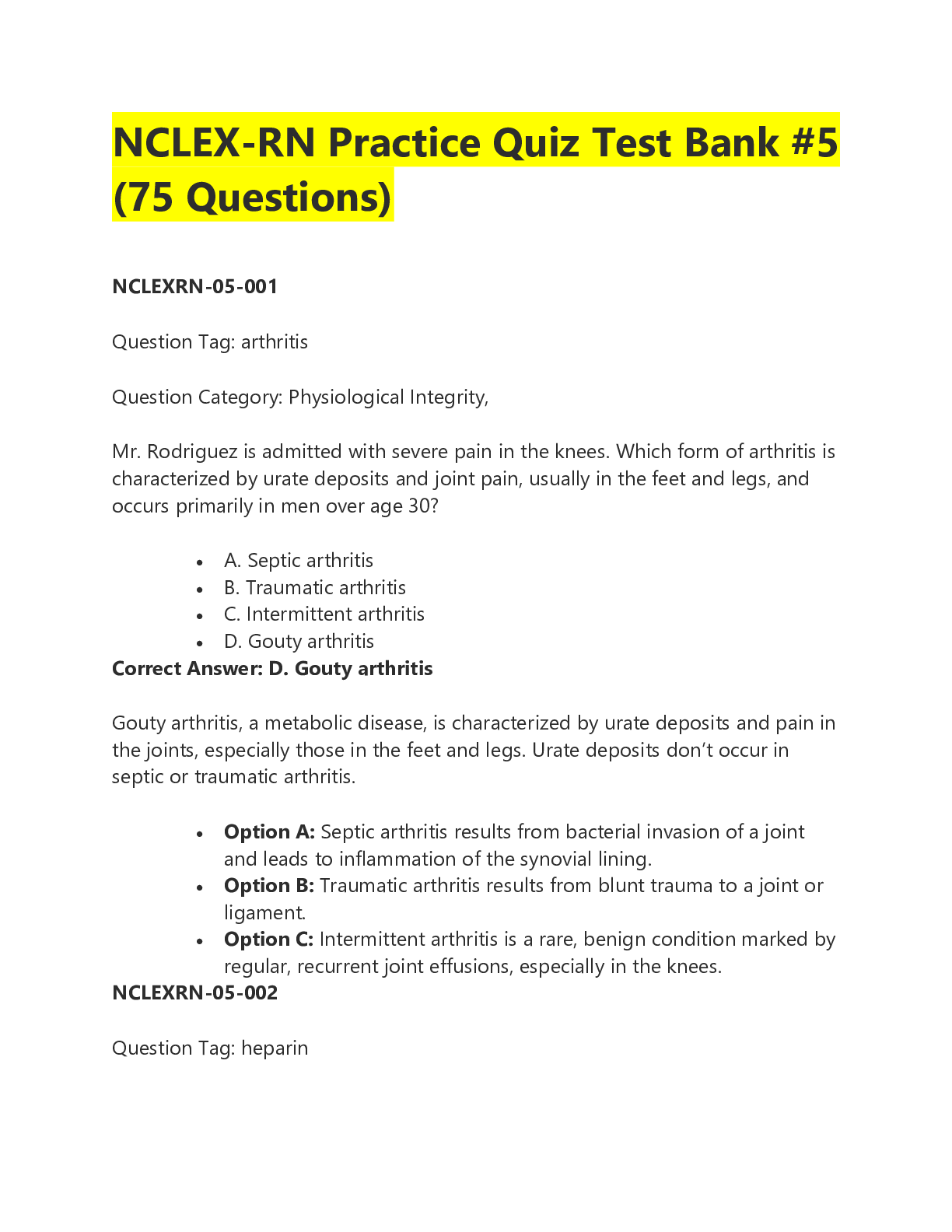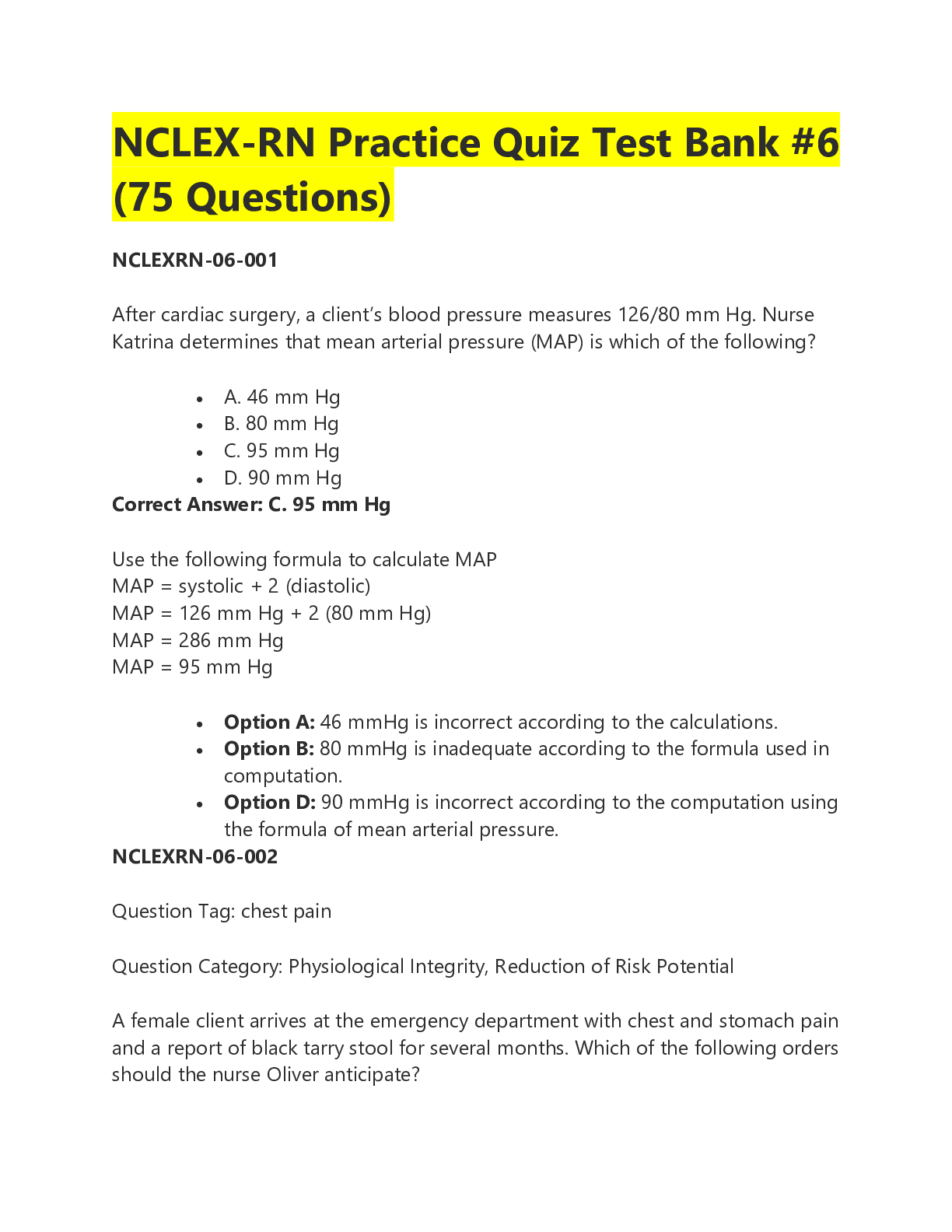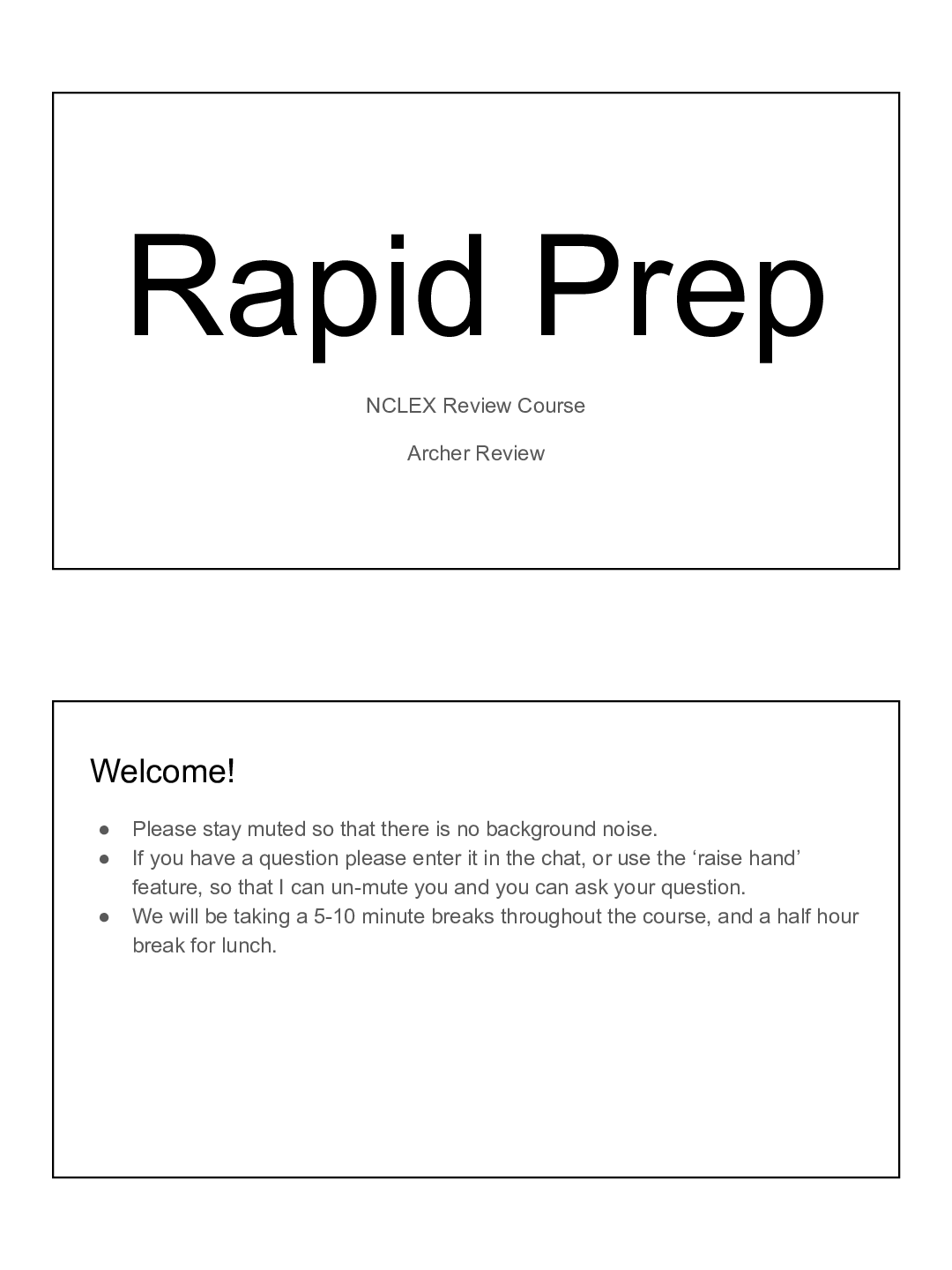NCLEX-RN Practice Quiz Test Bank #4 (75 Questions)
Document Content and Description Below
NCLEX-RN Practice Quiz Test Bank #4 (75 Questions) 1. 1. Question Which action(s) should you delegate to the experienced nursing assistant when caring for a patient with a thrombotic stroke with resid... ual left-sided weakness? Select all that apply. o A. Assist the patient to reposition every 2 hours. o B. Reapply pneumatic compression boots. o C. Remind the patient to perform active ROM. o D. Check extremities for redness and edema. Incorrect Correct Answer: A, B, & C. The experienced nursing assistant would know how to reposition the patient and how to reapply compression boots and would remind the patient to perform activities he has been taught to perform. • Option D: Assessing for redness and swelling (signs of deep venous thrombosis {DVT}) requires additional education and is still appropriate to the professional nurse. 2. 2. Question The patient who had a stroke needs to be fed. What instruction should you give to the nursing assistant who will feed the patient? • A. Position the patient sitting up in bed before you feed her. • B. Check the patient’s gag and swallowing reflexes. • C. Feed the patient quickly because there are three more waiting. • D. Suction the patient’s secretions between bites of food. Incorrect Correct Answer: A. Position the patient sitting up in bed before you feed her. Positioning the patient in a sitting position decreases the risk of aspiration. • Option B: The nursing assistant is not trained to assess gag or swallowing reflexes. • Option C: The patient should not be rushed during feeding. • Option D: A patient who needs to be suctioned between bites of food is not handling secretions and is at risk for aspiration. This patient should be assessed further before feeding. 3. 3. Question You have just admitted a patient with bacterial meningitis to the medical-surgical unit. The patient complains of a severe headache with photophobia and has a temperature of 102.60 F orally. Which collaborative intervention must be accomplished first? • A. Administer codeine 15 mg orally for the patient’s headache. • B. Infuse ceftriaxone (Rocephin) 2000 mg IV to treat the infection. • C. Give acetaminophen (Tylenol) 650 mg orally to reduce the fever. • D. Give furosemide (Lasix) 40 mg IV to decrease intracranial pressure. Incorrect Correct Answer: B. Infuse ceftriaxone (Rocephin) 2000 mg IV to treat the infection. Untreated bacterial meningitis has a mortality rate approaching 100%, so rapid antibiotic treatment is essential. • Option A: Pain medications may be given after treating the infection that is most probably causing it. • Option C: Acetaminophen should be given to decrease the fever after administering the antibiotics first. • Option D: Furosemide will help reduce CNS stimulation and irritation and should be implemented as soon as possible. 4. 4. Question You are mentoring a student nurse in the intensive care unit (ICU) while caring for a patient with meningococcal meningitis. Which action by the student requires that you intervene immediately? • A. The student enters the room without putting on a mask and gown. • B. The student instructs the family that visits are restricted to 10 minutes. • C. The student gives the patient a warm blanket when he says he feels cold. • D. The student checks the patient’s pupil response to light every 30 minutes. Incorrect Correct Answer: A. The student enters the room without putting on a mask and gown. Meningococcal meningitis is spread through contact with respiratory secretions so use of a mask and gown is required to prevent the spread of the infection to staff members or other patients. The other actions may not be appropriate but they do not require intervention as rapidly. • Option B: The presence of a family member at the bedside may decrease patient confusion and agitation. • Option C: Patients with hyperthermia frequently complain of feeling chilled, but warming the patient is not an appropriate intervention. • Option D: Checking the pupil response to light is appropriate, but it is not needed every 30 minutes and is uncomfortable for a patient with photophobia. Focus: Prioritization 5. 5. Question A 23-year-old patient with a recent history of encephalitis is admitted to the medical unit with new-onset generalized tonic-clonic seizures. Which nursing activities included in the patient’s care will be best to delegate to an LPN/LVN whom you are supervising? Select all that apply. • A. Document the onset time, nature of seizure activity, and postictal behaviors for all seizures. • B. Administer phenytoin (Dilantin) 200 mg PO daily. • C. Teach the patient about the need for good oral hygiene. • D. Develop a discharge plan, including physician visits and referral to the Epilepsy Foundation. • E. Gather information about the seizure activity Incorrect Correct Answer: B & E Administration of medications that are not a high risk is included in LPN education and scope of practice. Collection of data about the seizure activity may be accomplished by an LPN/LVN who observes initial seizure activity. An LPN/LVN would know to call the supervising RN immediately if a patient started to seize. • Option A: Documentation is a nursing responsibility. • Option C: Patient education must be accomplished by the registered nurse because it is within their scope of practice. • Option D: Planning of care is a complex activity that requires RN level education and scope of practice. 6. 6. Question While working in the ICU, you are assigned to care for a patient with a seizure disorder. Which of these nursing actions will you implement first if the patient has a seizure? • A. Place the patient on a non-rebreather mask will the oxygen at 15 L/minute. • B. Administer lorazepam (Ativan) 1 mg IV. • C. Turn the patient to the side and protect the airway. • D. Assess level of consciousness during and immediately after the seizure. Incorrect Correct Answer: C. Turn the patient to the side and protect the airway. The priority action during a generalized tonic-clonic seizure is to protect the airway. • Option B: Administration of lorazepam should be the next action since it will act rapidly to control the seizure. • Option A: Although oxygen may be useful during the postictal phase, the hypoxemia during tonic-clonic seizures is caused by apnea. • Option D: Checking the level of consciousness is not appropriate during the seizure, because generalized tonic-clonic seizures are associated with a loss of consciousness. 7. 7. Question A patient recently started on phenytoin (Dilantin) to control simple complex seizures is seen in the outpatient clinic. Which information obtained during his chart review and assessment will be of greatest concern? • A. The gums appear enlarged and inflamed. • B. The white blood cell count is 2300/mm3. • C. Patient occasionally forgets to take the phenytoin until after lunch. • D. Patient wants to renew his driver’s license next month. Incorrect Correct Answer: B. The white blood cell count is 2300/mm3. Leukopenia is a serious adverse effect of phenytoin and would require discontinuation of the medication. • Option A: Inflammation of the gums should be reported to the physician, but it does not require immediate attention. • Option C: The nurse should include in the patient teaching the importance of taking medications on time to avoid episodes of seizure. • Option D: Driving is prohibited for a client with a seizure disorder. This should be included in the patient’s teaching, but will not require a change in medical treatment for the seizures. 8. 8. Question After receiving a change-of-shift report at 7:00 AM, which of these patients will you assess first? • A. A 23-year-old with a migraine headache who is complaining of severe nausea associated with retching. • B. A 45-year-old who is scheduled for a craniotomy in 30 minutes and needs preoperative teaching. • C. A 59-year-old with Parkinson’s disease who will need a swallowing assessment before breakfast. • D. A 63-year-old with multiple sclerosis who has an oral temperature of 101.80 F and flank pain. Incorrect Correct Answer: D. A 63-year-old with multiple sclerosis who has an oral temperature of 101.80 F and flank pain. Urinary tract infections are a frequent complication in patients with multiple sclerosis because of the effect on bladder function. The elevated temperature and decreased breath sounds suggest that this patient may have pyelonephritis. The physician should be notified immediately so that antibiotic therapy can be started quickly. • Option A: This patient needs further assessment, but does not require immediate attention. A migraine can cause severe throbbing pain or a pulsing sensation, usually on one side of the head. It’s often accompanied by nausea, vomiting, and extreme sensitivity to light and sound. Migraine attacks can last for hours to days, and the pain can be so severe that it interferes with daily activities. • Option B: Preoperative teaching must be done but it is not the nurse’s priority. A craniotomy is the surgical removal of part of the bone from the skull to expose the brain. Specialized tools are used to remove the section of bone called the bone flap. The bone flap is temporarily removed, then replaced after the brain surgery has been done. • Option C: The patient should be assessed soon, but does not have an urgent need. In MS, the immune system attacks the protective sheath (myelin) that covers nerve fibers and causes communication problems between your brain and the rest of your body. Eventually, the disease can cause permanent damage or deterioration of the nerves. 9. 9. Question All of these nursing activities are included in the care plan for a 78-year-old man with Parkinson’s disease who has been referred to your home health agency. Which ones will you delegate to a nursing assistant (NA)? Select all that apply. • A. Check for orthostatic changes in pulse and blood pressure. • B. Monitor for improvement in tremor after levodopa (L-dopa) is given. • C. Remind the patient to allow adequate time for meals. • D. Monitor for abnormal involuntary jerky movements of extremities. • E. Assist [Show More]
Last updated: 8 months ago
Preview 1 out of 54 pages
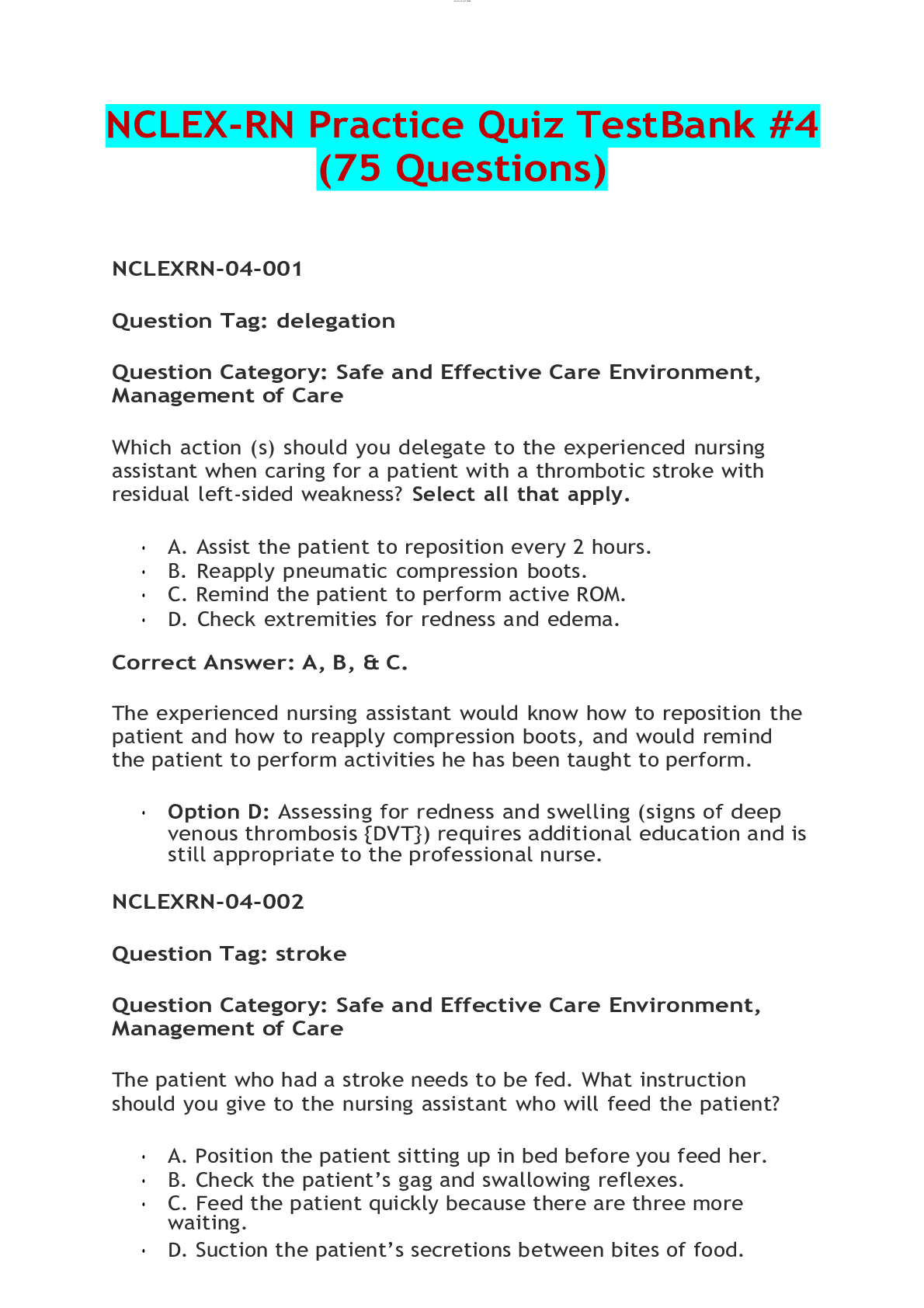
Buy this document to get the full access instantly
Instant Download Access after purchase
Add to cartInstant download
We Accept:

Also available in bundle (1)

NCLEX-RN Practice Quiz Test Bank SET 1-12 BUNDLE | (900 Questions in Total)
NCLEX-RN Practice Quiz Test Bank SET 1-12 BUNDLE | (900 Questions in Total)
By Ajay25 8 months ago
$50
12
Reviews( 0 )
$16.00
Document information
Connected school, study & course
About the document
Uploaded On
Oct 12, 2023
Number of pages
54
Written in
Additional information
This document has been written for:
Uploaded
Oct 12, 2023
Downloads
0
Views
61


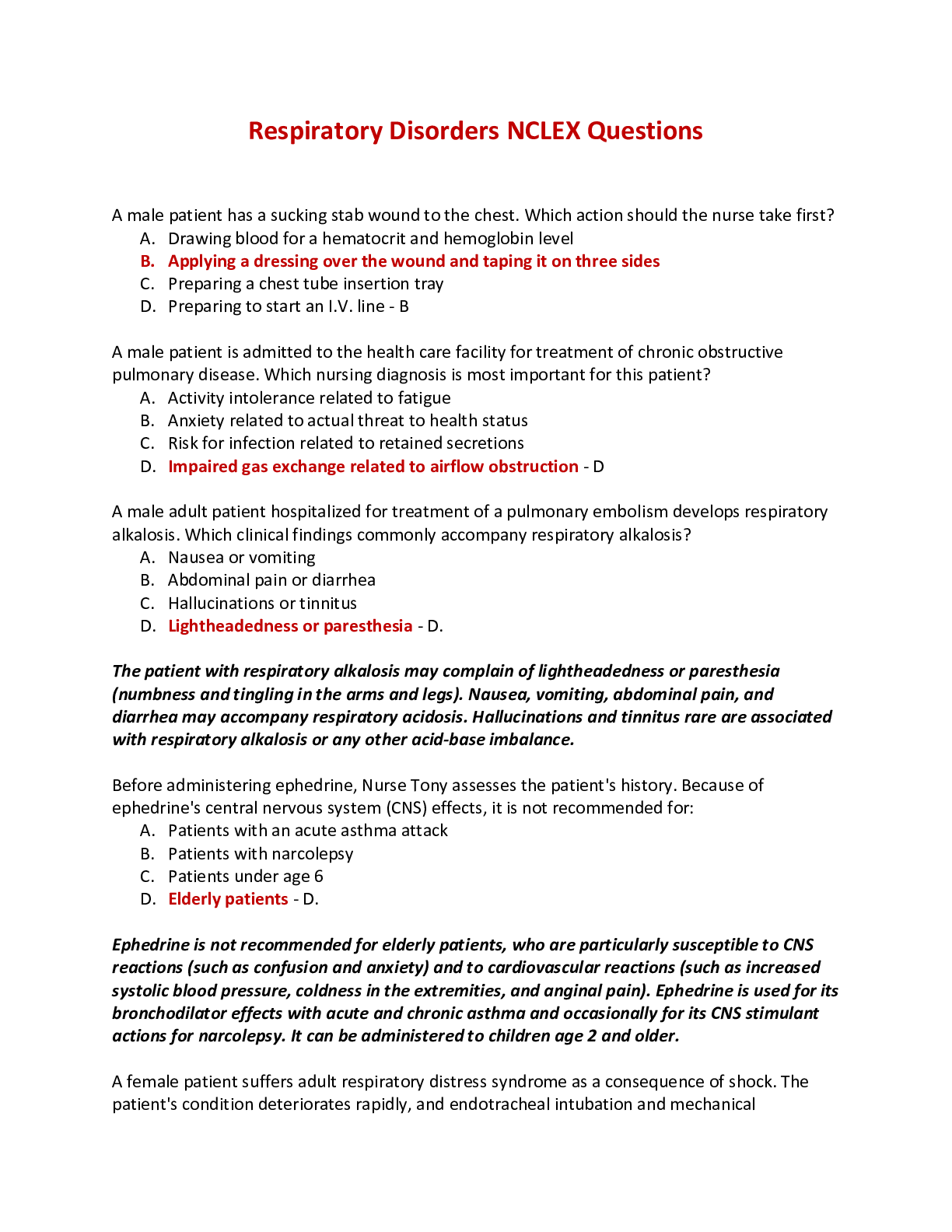
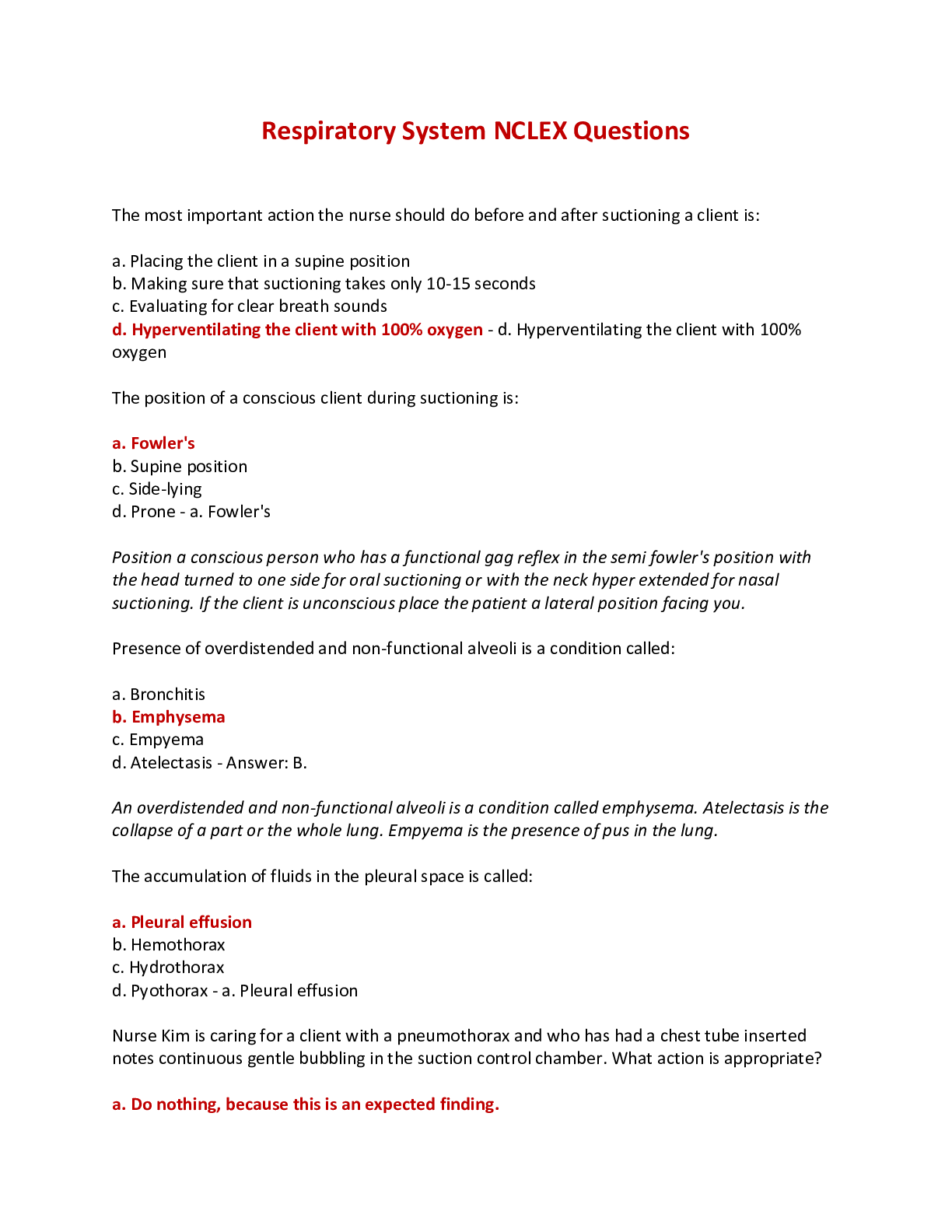
 NCLEX Study Guide.png)
